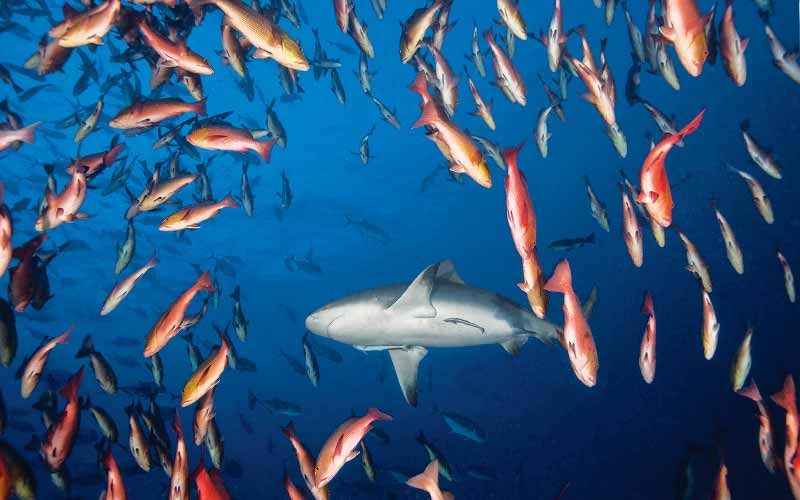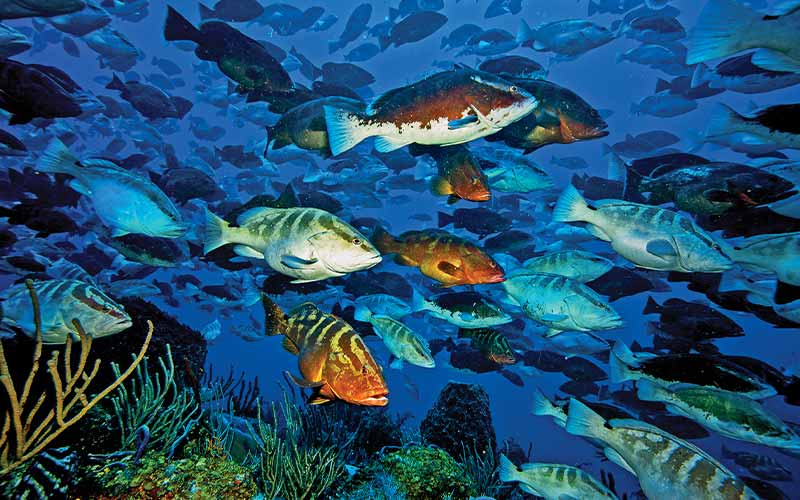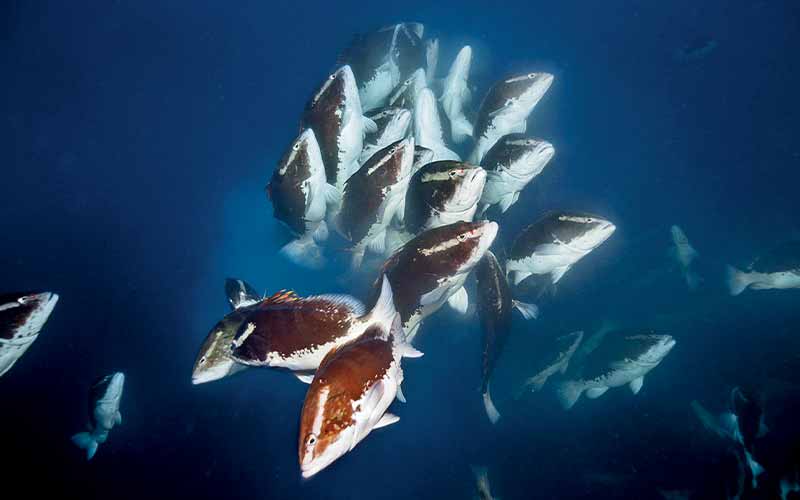The Two-Spot Red Snapper Spawn
By Richard Barnden
The moon’s influence resonates through history. It has inspired legends and folklore in cultures across the world; it lights the night for poets, sailors and travelers; and its pull on Earth’s waters is incessant and dependable.
We are only now discovering how much we rely on this distant giant for the functioning of our planet, and as exemplified by the tides, its greatest influence may be on the sea. Every month as the moon approaches its full phase, something special unfolds in the waters around Palau. Two-spot red snapper (Lutjanus bohar) gather at a few select locations in enormous spawning aggregations of tens of thousands of fish. They remain together amid frenzies of procreation for four to five days.
Each morning as the sun rises and the moon is close to setting, the snapper move from their aggregating areas to their nearby spawning areas. There they wait for the right combination of light and tide to signal the commencement of an underwater fireworks display of natural behavior.

As we scan the surface of the dark, still water, the pressure is on to find the fish and to determine in what stage of the spawning behavior they are. Timing is vital; diving in too soon would mean missing the peak action. After years of studying the snappers’ behavior, following their patterns and learning how to read the currents from the surface, we have developed a formula that, more often than not, allows us to predict the timing exactly. Mother Nature keeps us on our toes, though, and it’s always a relief to find the school early and monitor it as the divers get ready.
This dive is not for everyone. It can involve strong currents, blue-water diving off the reef, fighting current, getting up at 4 a.m. and swimming among some of the ocean’s most formidable sharks: bulls and oceanic blacktips.
As soon as you descend it’s obvious something is happening — you can feel the excitement in the water. Adrenaline takes over, and you suddenly realize you’re in the zone when a 10-foot bull shark comes slowly from the darkness straight at you and passes only a few feet away.
The dive plan depends on the current. The fish wait for a specific current state to move up high into the water column and form a tight ball to begin spawning. Trying to keep up with fornicating fish means using a little more air than you normally would, so it’s imperative to keep an eye on your gauge.
It’s not just the spawning behavior that’s fascinating; even before the spawning takes place a highway effect occurs on the plateau. The fish move from the reef out into the blue water and back onto the reef and then out again, forming huge columns. During this time sexual dimorphism (a difference in appearance between males and females) exists: A white band appears down the entire lateral line of the females’ normally red bodies.
As soon as all the variables line up, the main event begins to unfold. The school rises from the depths and erupts in the shallower water. The snapper begin swimming fast to the surface, writhing and rubbing together and forming a cone-shaped torpedo. Finally a large cloud of gametes (sperm and eggs) erupts from the wriggling fish, and potentially millions of two-spot red snapper are born before your eyes. Everywhere you look spawning is happening, and it’s overwhelming.
We have been documenting this event every month for several years now, but it remains difficult to know where to point your camera. The visibility diminishes to only a few feet as the gametes turn the crystal-blue water into a milky mass of procreation. Soon it’s time to head back to the reef as another bull shark and a pair of oceanic blacktips appear out of the milk and turn back into the tiring mass of fish in search of an easy meal. The action continues with the sharks patrolling around the outside and often breaking into the school to strike. The snapper seem oblivious to the huge predators hunting them — the reproduction must go on.
Why the snapper return to these select locations every month we are only just beginning to understand. Through years of research and observation we have come to believe these locations offer the right conditions for the offspring to be carried out to sea to begin their struggle for survival as pelagic larvae. They must remain drifting for weeks or even months, dodging hungry mouths before returning to the safety of nurseries such as mangroves or inner lagoons, where they will grow until they are sexually mature and can return to the place from which they came to continue the circle of life.
Grouper Moon
By Brice Semmens, Ph.D., and Christy Pattengill-Semmens, Ph.D.
The Nassau grouper is a Caribbean icon: It’s routinely featured on wish-you-were-here postcards, magazine covers and stamps. To many divers Nassau groupers are an embodiment of a healthy reef. As large predators with healthy appetites, they play an important role in maintaining the structure of reef ecosystems, and their puppy-dog personality makes encountering them a unique treat.
During the last century, Nassau grouper represented one of the Caribbean’s most economically important fisheries. The fish are normally solitary and territorial, but during the winter full moons they aggregate to spawn. Historically, Nassau grouper aggregations comprised tens of thousands of fish, but this abundance of fish and the aggregation’s predictability in time and space presents an irresistible draw to fishermen. As a result, only a handful of known Nassau grouper aggregations with more than 1,000 fish remain in the Caribbean. Across their entire range, Nassau grouper populations have dwindled to just a fraction of historic numbers. Recognizing this decline, the International Union for Conservation of Nature (IUCN) declared the species as endangered in 2003. Currently, Nassau grouper are listed as a candidate for the U.S. Endangered Species list.
Although some governments have taken steps to protect spawning sites, in most instances protections came after population collapse. But the Cayman Islands is an exception. In 2001 fishermen discovered approximately 7,000 aggregating Nassau grouper off the west end of Little Cayman. At the time all other known Nassau grouper aggregations in the Cayman Islands had been fished to exhaustion. In the first two years following discovery, fishermen took more than half of the aggregating fish. Fortunately, in 2003 the Cayman Islands Marine Conservation Board instituted an eight-year fishing ban on Nassau grouper at all known aggregation sites. This ban protected the aggregation while it still hosted many thousands of fish, and today it is the largest known aggregation in the Caribbean.

In the winter of 2002, the U.S.-based marine conservation organization Reef Environmental Education Foundation (REEF) and the Cayman Islands Department of Environment (CIDOE) initiated the Grouper Moon Project, a long-term research and education program focused on this unique aggregation site. REEF and CIDOE have coordinated annual efforts to monitor and study the Little Cayman aggregation as well as several remnant aggregations off Cayman Brac and Grand Cayman. The Grouper Moon Project research has grown in scope to include studies of fish movements and migrations, juvenile habitat, genetic studies, understanding behavioral and environmental cues used by the aggregating fish, aggregations of other species at the site and a project to understand how currents and other oceanographic conditions determine the role of the Little Cayman aggregation in repopulating Caribbean reefs.
Findings from the Grouper Moon Project indicate policy actions are indeed working. Based on project results, the conservation board extended the protections for an additional eight years starting in 2011, and the Cayman government is currently reviewing a broader package of permanent conservation rules. This package includes a proposal for permanent year-round protection of the spawning sites due to the extensive use of these important places by dozens of other fish species.

Educating the next generation of Caymanians is an important aspect of the Grouper Moon Project. With support from the Disney Worldwide Conservation Fund, REEF has created an education program for local schools. Students learn about the grouper’s historical role in Caribbean culture and the precipitous population decline. In addition to lesson plans, the curriculum includes live-feed webcasts using state-of-the-art underwater video and communication technology. This participatory approach to learning allows students to engage with Grouper Moon scientists and experience what it’s like to swim among thousands of Nassau grouper at one of the last great aggregations of this endangered species.
© Alert Diver — Q3 Summer 2014